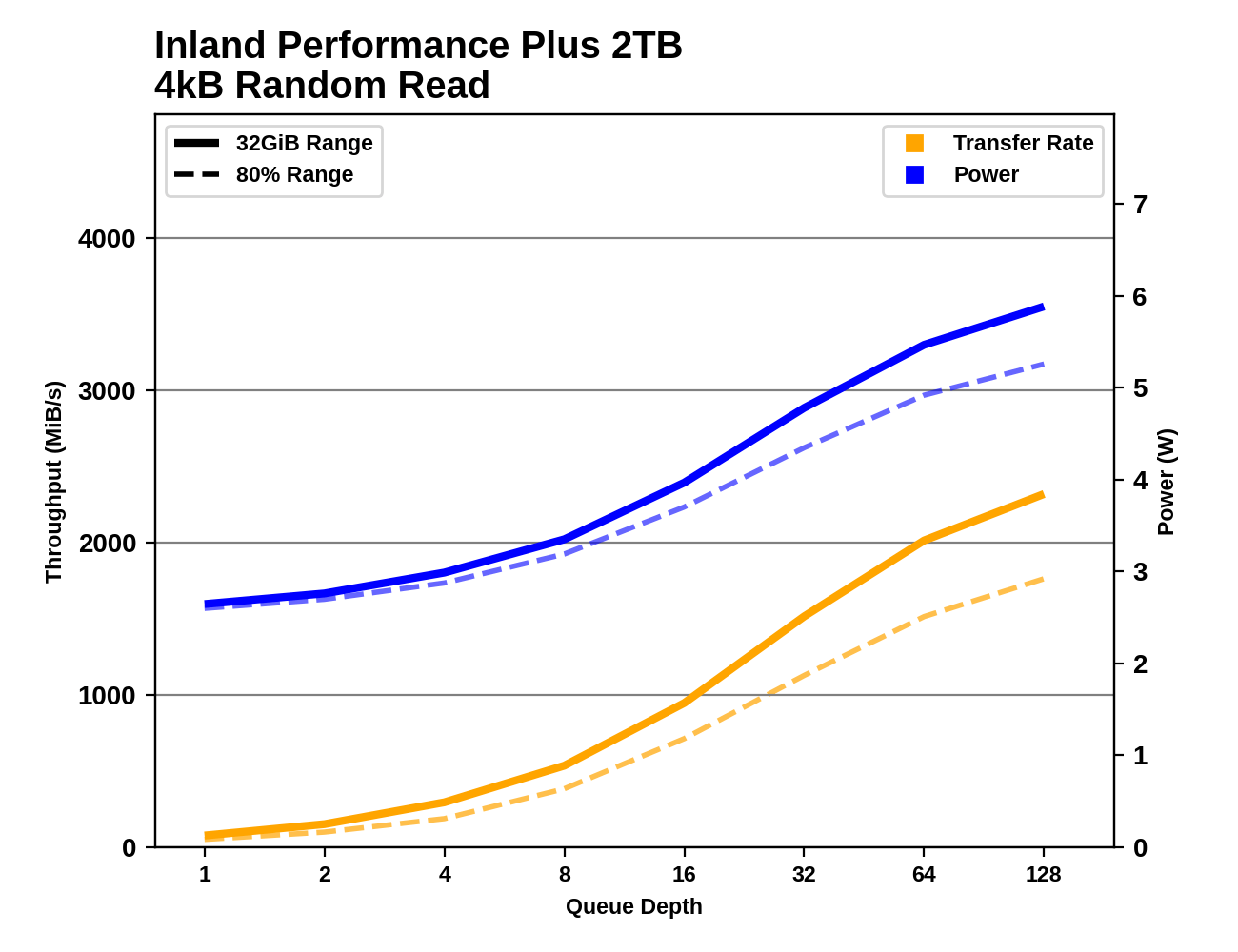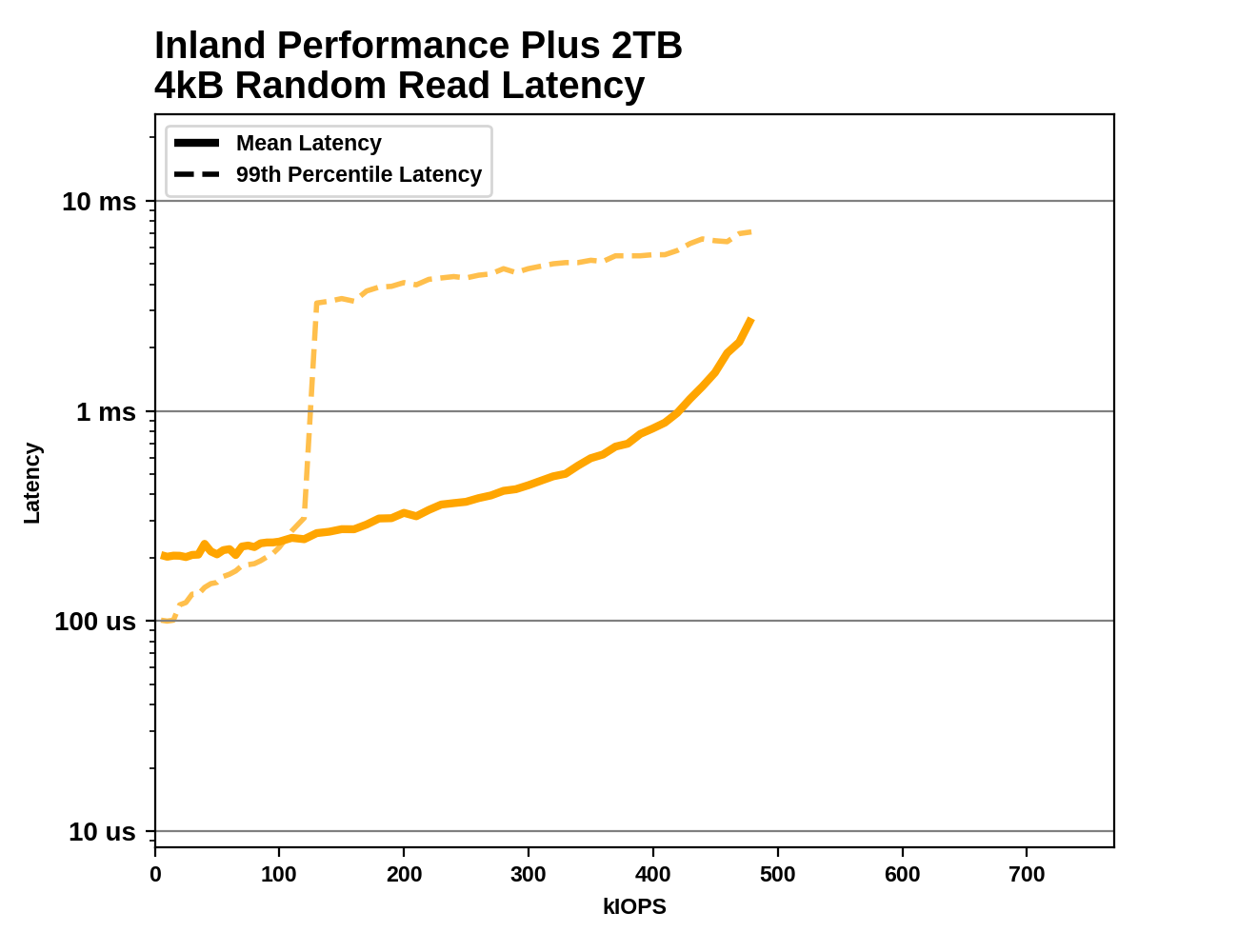The Inland Performance Plus 2TB SSD Review: Phison's E18 NVMe Controller Tested
by Billy Tallis on May 13, 2021 8:00 AM ESTBurst IO Performance
Our burst IO tests operate at queue depth 1 and perform several short data transfers interspersed with idle time. The random read and write tests consist of 32 bursts of up to 64MB each. The sequential read and write tests use eight bursts of up to 128MB each. For more details, please see the overview of our 2021 Consumer SSD Benchmark Suite.
 |
|||||||||
| Random Read | Random Write | ||||||||
| Sequential Read | Sequential Write | ||||||||
On the QD1 burst IO tests, the Inland Performance Plus tops the charts for both random and sequential writes, though in the latter case performance drops quite a lot when the drive is mostly full. Random read performance is merely average, and sequential reads are disappointingly in last place.
Sustained IO Performance
Our sustained IO tests exercise a range of queue depths and transfer more data than the burst IO tests, but still have limits to keep the duration somewhat realistic. The primary scores we report are focused on the low queue depths that make up the bulk of consumer storage workloads. For more details, please see the overview of our 2021 Consumer SSD Benchmark Suite.
 |
|||||||||
| Random Read | Throughput | Power | Efficiency | ||||||
| Random Write | Throughput | Power | Efficiency | ||||||
| Sequential Read | Throughput | Power | Efficiency | ||||||
| Sequential Write | Throughput | Power | Efficiency | ||||||
On the longer IO tests that bring in some higher queue depths, the Performance Plus loses its first-place spot for random writes to the WD Black SN850, but it hangs on to first place for sequential writes. For both random and sequential reads it manages to improve its standings slightly, but the sequential read performance remains disappointing. Power efficiency isn't great on any of these four tests, but it's decent for sequential writes and more or less matches the flagship Gen4 drives from WD and Samsung.
 |
|||||||||
| Random Read | |||||||||
| Random Write | |||||||||
| Sequential Read | |||||||||
| Sequential Write | |||||||||
The Inland Performance Plus does eventually reach top-tier performance for sequential reads, but it requires higher queue depths than the 980 PRO or SN850. For sequential writes, it has taken a clear lead by QD4 and maintains higher performance than any of the other drives can hit, with only a slight drop at the end of the test suggesting that the SLC cache might be starting to run out.
For random reads and writes, the Performance Plus simply doesn't scale up as high as its competitors, even with very large queue depths. The Samsung 980 PRO's maximum random write speeds are well beyond what any other drive hits, and for random reads the WD Black SN850 has a similarly large lead over the competition.
Random Read Latency
This test illustrates how drives with higher throughput don't always offer better IO latency and Quality of Service (QoS), and that latency often gets much worse when a drive is pushed to its limits. This test is more intense than real-world consumer workloads and the results can be a bit noisy, but large differences that show up clearly on a log scale plot are meaningful. For more details, please see the overview of our 2021 Consumer SSD Benchmark Suite.
 |
|||||||||
At low rates, the mean latency from the Inland Performance Plus is actually higher than the 99th percentile latency, indicating there's a small number of extremely high-latency IOs skewing the average. The median latency starts at a very respectable 63µs, but the highest latency measured at low rates is close to 70ms—three orders of magnitude slower. This looks like the drive might be stalling while waking up from a sleep state, which it shouldn't even be entering given the minimal idle time between test phases. Above 120k IOPS, the 99th percentile latency jumps up to the millisecond range, which should only happen to a drive this high-end when it's pretty close to its maximum throughput. The Performance Plus does achieve respectable throughput that is a clear improvement over the Phison E16, but compared to WD and Samsung flagships the E18 drive is slower and has some mildly concerning performance quirks.










118 Comments
View All Comments
Billy Tallis - Thursday, May 13, 2021 - link
Single-core performance can help with a lot of synthetic storage benchmarks, by making for faster context switches and system calls. But if you care about such marginal improvements, I suspect we would find that dropping Windows and using Linux instead will have a far greater impact on storage performance and OS overhead.I don't recall any of the PCIe 4.0 SSD controller vendors complaining about AMD's PCIe implementation being a bottleneck.
mode_13h - Thursday, May 13, 2021 - link
@thestryker is right that Intel claimed faster PCIe 4 SSD performance than the competition, in one of their Rocket Lake slides. I think it was like 20%, but now I can't find the slide.I was so struck by it that I clearly remember it, and was wondering if they were talking about a PCIe 4.0 drive connected to Ryzen via its chipset link. Because that's the only way it made sense to me.
GeoffreyA - Friday, May 14, 2021 - link
"connected to Ryzen via its chipset link"That's a possibility.
Spunjji - Friday, May 14, 2021 - link
Ryan Shrout released the information in February, and it was 11%. The claim was based on performance from the PCMark 10's "quick" storage benchmark. Apparently the drives being tested were connected to a riser card in a secondary PCIe slot, which was an odd decision as X570 supports connecting the SSD directly to the CPU via the M.2 slots.It looks like they found a benchmark that favoured their setup specifically and went with it.
Slash3 - Friday, May 14, 2021 - link
Rocket Lake itself also has a dedicated CPU connected NVMe M.2 slot. The whole setup was just absurd.carcakes - Thursday, May 13, 2021 - link
Experience the Best of Both Worlds: 8x M.2 Ports @ x16 PCIe 4.0 Speed!1x HighPoint SSD7540 PCIe Gen4 x16 8-Port M.2 NVMe RAID Controller + 8x ASRock Legacy M.2 Graphics Card.
mode_13h - Thursday, May 13, 2021 - link
That's more expensive, chews up PCIe lanes, and can only hurt read latency. Plus, having faster SSDs to put in a RAID makes such configurations even faster!Dug - Thursday, May 13, 2021 - link
So what you are really saying is, buy the WD SN850 instead of this.Oxford Guy - Friday, May 14, 2021 - link
Looks like the ADATA is the price-performance winner for budget buyers.Alexvrb - Thursday, May 13, 2021 - link
When the 176L-equipped models with tuned firmware roll around, they just might take the crown.Then again, until hardware-accelerated DirectStorage titles start coming out, I don't think there's much benefit for me. Even then, only for titles that have some extremely large assets that need to be streamed in and don't fit in RAM... DS is far more beneficial for consoles since they need to save money wherever possible - mainly RAM.